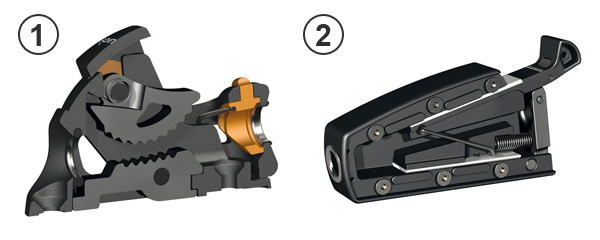For good cordage holding
Diameter and materials
It may be necessary for practical reasons to install blocks (return manoeuvres, unfurling rope…) or simply to replace existing models. The choice should always be determined by the cordage diameter. A block is always used for a minimum and maximum diameter of rope, or for minimum, recommended, maximum. For example 6 to 10 mm or 6, 8, 10mm. Every time, a maximum workload is also given (e.g.500kg.) Recently, certain blocks have been created for specified materials (Kevlar ® aramid ®...) which have a tendency to slip in standard blocks. When one installs a block, it is necessary to take a model for the diameter of rope. For example, for cord of 10mm, one takes a model suited for 8 to 12mm. The workload is more
difficult to estimate. Fortunately, it is often dependent on the diameter of the rope.
For halyards on a cruiser from 10 to 15 m, the recommended load is 1000 kg (blocks 8-14 mm), on a boat of 6 to 10 m, it is 500 kg (blocks 8 to 12 mm.)
If for a given cordage, we take the corrseponding diameter to the max limited value of the block (a block 8 to 10mm for rope of 10mm,)the hold will be better but the rope tends to wear more rapidly. If we choose a line of smaller diameter than the capacity of the block, the rope tends to slide.
difficult to estimate. Fortunately, it is often dependent on the diameter of the rope.
For halyards on a cruiser from 10 to 15 m, the recommended load is 1000 kg (blocks 8-14 mm), on a boat of 6 to 10 m, it is 500 kg (blocks 8 to 12 mm.)
If for a given cordage, we take the corrseponding diameter to the max limited value of the block (a block 8 to 10mm for rope of 10mm,)the hold will be better but the rope tends to wear more rapidly. If we choose a line of smaller diameter than the capacity of the block, the rope tends to slide.
How does it work?
The block provides two functions; in the closed position it prevents the cord leaving but it also frees the cord when holding its tension (thanks to the winch.) Simply, the rope is free in one direction but not the other. The control lever is used to release the rope in both directions. The internal mechanism which provides these functions must do it without damaging the rope (notably the sheath) and work on all types, including unusual fibres (which may provide less hold than polyester.)
The maximum charge announced by manufacturers is the maximum hold in the cleat. It does not correspond to the pressure at which one may drop the rope with the lever (under weight.)For release under a certain weight (variable according to blocks,) it is necessary to hold the rope tension with a winch. Last, when you release the rope from the winch, there is always a withdrawal of the rope a few inches in the block. This must be considered for certain manoeuvres such as excessively tensioned halyards.

The maximum charge announced by manufacturers is the maximum hold in the cleat. It does not correspond to the pressure at which one may drop the rope with the lever (under weight.)For release under a certain weight (variable according to blocks,) it is necessary to hold the rope tension with a winch. Last, when you release the rope from the winch, there is always a withdrawal of the rope a few inches in the block. This must be considered for certain manoeuvres such as excessively tensioned halyards.

